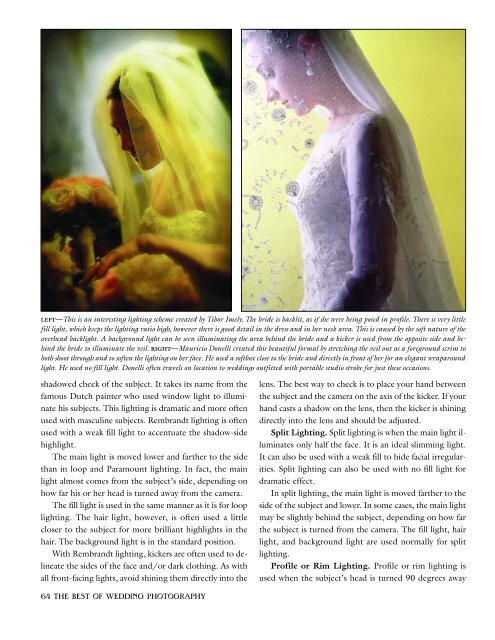The Best of Wedding Photography.pdf - Free
The Best of Wedding Photography.pdf - Free
The Best of Wedding Photography.pdf - Free
You also want an ePaper? Increase the reach of your titles
YUMPU automatically turns print PDFs into web optimized ePapers that Google loves.
LEFT—This is an interesting lighting scheme created by Tibor Imely. <strong>The</strong> bride is backlit, as if she were being posed in pr<strong>of</strong>ile. <strong>The</strong>re is very little<br />
fill light, which keeps the lighting ratio high, however there is good detail in the dress and in her neck area. This is caused by the s<strong>of</strong>t nature <strong>of</strong> the<br />
overhead backlight. A background light can be seen illuminating the area behind the bride and a kicker is used from the opposite side and behind<br />
the bride to illuminate the veil. RIGHT—Mauricio Donelli created this beautiful formal by stretching the veil out as a foreground scrim to<br />
both shoot through and to s<strong>of</strong>ten the lighting on her face. He used a s<strong>of</strong>tbox close to the bride and directly in front <strong>of</strong> her for an elegant wraparound<br />
light. He used no fill light. Donelli <strong>of</strong>ten travels on location to weddings outfitted with portable studio strobe for just these occasions.<br />
shadowed cheek <strong>of</strong> the subject. It takes its name from the<br />
famous Dutch painter who used window light to illuminate<br />
his subjects. This lighting is dramatic and more <strong>of</strong>ten<br />
used with masculine subjects. Rembrandt lighting is <strong>of</strong>ten<br />
used with a weak fill light to accentuate the shadow-side<br />
highlight.<br />
<strong>The</strong> main light is moved lower and farther to the side<br />
than in loop and Paramount lighting. In fact, the main<br />
light almost comes from the subject’s side, depending on<br />
how far his or her head is turned away from the camera.<br />
<strong>The</strong> fill light is used in the same manner as it is for loop<br />
lighting. <strong>The</strong> hair light, however, is <strong>of</strong>ten used a little<br />
closer to the subject for more brilliant highlights in the<br />
hair. <strong>The</strong> background light is in the standard position.<br />
With Rembrandt lighting, kickers are <strong>of</strong>ten used to delineate<br />
the sides <strong>of</strong> the face and/or dark clothing. As with<br />
all front-facing lights, avoid shining them directly into the<br />
64 THE BEST OF WEDDING PHOTOGRAPHY<br />
lens. <strong>The</strong> best way to check is to place your hand between<br />
the subject and the camera on the axis <strong>of</strong> the kicker. If your<br />
hand casts a shadow on the lens, then the kicker is shining<br />
directly into the lens and should be adjusted.<br />
Split Lighting. Split lighting is when the main light illuminates<br />
only half the face. It is an ideal slimming light.<br />
It can also be used with a weak fill to hide facial irregularities.<br />
Split lighting can also be used with no fill light for<br />
dramatic effect.<br />
In split lighting, the main light is moved farther to the<br />
side <strong>of</strong> the subject and lower. In some cases, the main light<br />
may be slightly behind the subject, depending on how far<br />
the subject is turned from the camera. <strong>The</strong> fill light, hair<br />
light, and background light are used normally for split<br />
lighting.<br />
Pr<strong>of</strong>ile or Rim Lighting. Pr<strong>of</strong>ile or rim lighting is<br />
used when the subject’s head is turned 90 degrees away

















